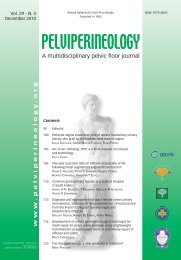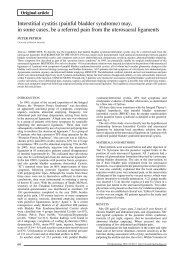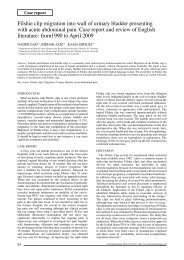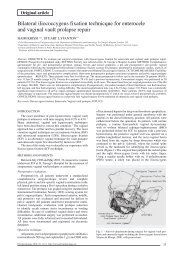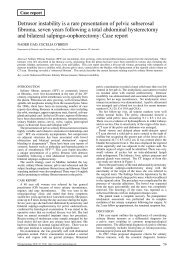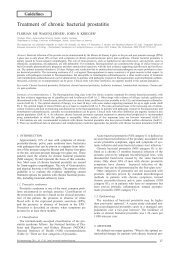This Issue Complete PDF - Pelviperineology
This Issue Complete PDF - Pelviperineology
This Issue Complete PDF - Pelviperineology
You also want an ePaper? Increase the reach of your titles
YUMPU automatically turns print PDFs into web optimized ePapers that Google loves.
Original article<br />
Histotopographic study of the pubovaginalis muscle<br />
VERONICA MACCHI (*) - ANDREA PORZIONATO (*) - ENRICO VIGATO (*) - CARLA STECCO (*)<br />
ANTONIO PAOLI (*) - ANNA PARENTI (**) - GIUSEPPE DODI (***) - RAFFAELE DE CARO (*)<br />
(*) Section of Anatomy, Department of Human Anatomy and Physiology, University of Padova, Italy<br />
(**) Section of Pathologic Anatomy, Department of Oncological and Surgical Sciences, University of Padova, Italy<br />
(***) Section of Surgery, Department of Oncological and Surgical Sciences, University of Padova, Italy<br />
Abstract: The pubovaginalis muscle (PVM) is one of the described components of the pubococcygeus muscle. The aim of the study was to<br />
investigate its topography and histological characteristics. After in situ formalin fixation, the pelvic viscera were removed from 16 female<br />
cadavers (range of age: 54-72 years). Serial macrosections of the pelvic viscera and pelvic floor complex, cut in horizontal (8 cases) and coronal<br />
(8 cases) planes, underwent histological and immunohistochemical study. PVM was identified in 13/16 (81%) specimens. In both coronal and<br />
transverse sections it appears as a layer of muscular tissue at the passage of the inferior and middle thirds of the vagina, along the lateral vaginal<br />
walls. In coronal sections, it appeared as a fan-shaped layer of muscular tissue, arising from the pubococcygeus muscle, running with an oblique<br />
course towards the lateral vaginal walls. The mean (± SD) thickness of the PVM was 1.8 (± 1.25) mm. In the transverse sections, a bundle of<br />
muscle fibres with oblique course splits from the medial margin of the pubococcygeus muscle towards the lateral walls of the vagina, mingling<br />
with the outer longitudinal fibers of the muscular layer of the vagina. Immunohistochemical stainings showed that it consisted predominantly of<br />
striated muscle fibers. The PVM could represent anatomical evidence of a functional connection between the vagina and the muscular system<br />
of the pelvic floor.<br />
Key words: Female pelvis; Dissection; Levator ani muscle.<br />
INTRODUCTION<br />
The levator ani muscle is considered the most important<br />
supportive system of the pelvic floor and has been divided<br />
into many portions, according to their attachments or physiological<br />
functions. Standring et al. 1 subdivide the levator<br />
ani muscle into the ischiococcygeus, iliococcygeus and pubococcygeus<br />
portions. The pubococcygeus muscle is often<br />
subdivided into separate parts according to the pelvic viscera<br />
to which they relate, i.e. pubourethralis and puborectalis<br />
in the male, pubovaginalis (PVM) and puborectalis in the<br />
female. At the level of the vagina and the rectum, the muscle<br />
bundles of the pubococcygeus muscle are continuous with<br />
those controlateral, forming a sling (pubovaginalis and puborectalis).<br />
From the functional point of view, Hanzal et al. 2<br />
and Ashton-Miller and De Lancey 3 describe three regions of<br />
the levator ani muscle: the iliococcygeal portion (that is flat<br />
and relatively horizontal and spans the potential gap from<br />
one pelvic sidewalls to the other), the pubovisceral muscle<br />
(the portion of the levator ani that arises from the pubic bone<br />
on either side attaching to the walls of the pelvic organs and<br />
the perineal body), and the puborectal muscle. The pubovisceral<br />
muscle consists of three subdivisions: the puboperineus,<br />
the PVM and the puboanalis. Shafik 4-5 suggests that<br />
the levator ani muscle consists essentially of the pubococcygeus,<br />
the iliococcygeus being rudimentary in humans;<br />
the puborectalis muscle does not belong to the levator ani<br />
muscle, having different origin, innervation and function<br />
(the former being a constrictor, the latter a dilator of the intrahiatal<br />
organs).<br />
Kearney et al. 6 found sixteen terms used for the different<br />
portions of the levator ani muscle, differences that may be<br />
in consequence of the preponderance of studies conducted<br />
on male subjects. The difference of opinions concerning the<br />
anatomy of the levator ani 7 reflects also on the description<br />
and terminology of the PVM. Lawson 8 called the muscular<br />
fibers that join the vaginal wall to the pubic bone as the<br />
‘pubovaginalis/pubourethralis’, whereas the same structure<br />
has been called as the ‘pubococcygeus’ by Curtis et al. 9 and<br />
Roberts et al., 10 ‘puborectalis’ by Courtney, 11 ‘pelvic fibers<br />
of anterior layer’ by Ayoub 12 and ‘superficial perineal layer<br />
of anterior fibers’ by Bustami. 13 Furthermore, Smith 14 states<br />
that these muscular fibers arising from the pubis just run<br />
adjacent but do not insert into the wall of the vagina. The<br />
<strong>Pelviperineology</strong> 2008; 27: 7-9 http://www.pelviperineology.org<br />
“Terminologia Anatomica” 15 mentions the PVM, referring<br />
to those bundles of the pubococcygeus which surround the<br />
vagina, intermingling with the controlateral ones.<br />
The microscopic anatomy of the PVM is poorly described.<br />
DeLancey and Starr 16 studied the histology of the connection<br />
of the vagina with the medial portion of the levator<br />
ani muscles, in the region of the proximal urethra. Thus,<br />
the term ‘pubovaginalis’ has also been used for the ‘pubourethralis’<br />
muscle, defined as the portion of the levator ani<br />
muscle that is attached to the urethral supports. A damage of<br />
this part of the levator ani muscle might affect urethral support.<br />
6<br />
The aim of the present study was to investigate the histological<br />
structure, the characteristics and topography of the<br />
PVM in order to evaluate its role in static and dynamic of<br />
the pelvic floor.<br />
MATERIALS AND METHODS<br />
Sampling of pelvic viscera<br />
Specimens were obtained from 16 female cadavers (age<br />
range: 54-72 years), with anamnesis negative for pelvic<br />
pathology. All the subjects were postmenopausal. The pelvic<br />
viscera and pelvic floor were sampled according to a protocol<br />
previously described. 17-19<br />
Histology<br />
Twelve specimens were fixed in 10% formalin for 15 days<br />
and then 5-mm thick slices were cut in the transverse (8<br />
cases) plane. Four thick transverse slices of the vagina were<br />
sampled. Two slices, one cranial and one caudal, were collected<br />
at the level of the middle third of the vagina, and two<br />
slices, one cranial and one caudal, were sampled at the level<br />
of the inferior third of the vagina (levels II and III respectively,<br />
according to DeLancey. 20 Moreover 8 cases were cut<br />
on coronal plane. The slices were embedded in paraffin and<br />
then cut into 10-m thick sections, which were stained with<br />
hematoxylin and eosin (H.E.), azan-Mallory and Weigert’s<br />
Van Gieson stain for elastic fibres. In the histological sections,<br />
the course and characteristics of the PVM were analysed.<br />
Topographical relationships with the vagina, rectum,<br />
and aponeurotic structures of the perineum were also evaluated.<br />
Morphometric evaluation was carried out with the help<br />
of image analysis software (Qwin Leica Imaging System,<br />
7



